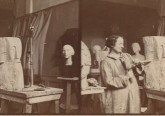translation Florence Le Provost
« Matisse Paires et Séries », a landmark exhibition at the Pompidou Centre : some sixty works by Matisse will be presented in pairs or in series from 7 March to 18 June 2012, thus highlighting one of the distinctive aspects of the French artist's work —, the serial treatment of theme and motif.
The canvases by Henri Matisse which will be presented at the Pompidou Centre on the occasion of the « Matisse: Pairs and series » exhibition were assembled from the most outstanding public and private collections across the world. Among them are four large gouache cutouts and thirty or so drawings, probably brought together for the first time since their creation.
Cecile Debray, curator of the exhibition, explains : « I wanted to show the consistency of his works through the fundamentally distinctive and continuous aspect that prevails in his art - the serial treatment of theme and motif expressed in variations of framing, either in pairs or in series ».
The exhibition will offer the public the opportunity to measure how Matisse's work helped prompt modern painting, constantly posing the question of representation, of realism, and of the articulation between line and colour, between surface and space, between interiority and exteriority.
Matisse : a profound student of form
From the pointillism he experimented with, in the summer of 1904 - Luxe, Calme et Volupté and Le Goûter being brought together here in a rare opportunity —, up to the ambitious paper cutouts of the 1950s —, with the famous Nu bleu series of 1952 —, including his Thèmes et variations series, the major periods of the artist's carreer are being represented in chronological order.
« The works were selected upon precise requirements as to chronology and standard —, with groups that were achieved within the same time interval and characteristic of Matisse's art periods. This choice is meant to illustrate the regularity of his line of work and to help highlight the relationship between each work and its context of creation by comparing them with the « sister » works they used to converse with in the artist's studio », Cécile Debray points out.
The Romanian Blouse and The Dream
His repeated exploration of the same subjects and motifs enabled Matisse to explore painting itself.
Henri Matisse, The Romanian Blouse, Novembre 1939 —, April 1940
Gift of the artist, 1953, Musée national d'art moderne, Centre Pompidou © Estate of Henri Matisse.
Henri Matisse, The Dream, 1940
Private Collection © Estate of Henri Matisse.
About these two paintings, Matisse writes :
« Fortunately I have almost -or, quite, maybe- finished a painting which I started a year ago, and which was quite an adventure. Above all, very realistic, the painting depicted a beautiful woman sleeping on a marbled-topped table amid fruit strewn across the table's surface. She metamorphosed into an angel sleeping on a purple surface —, the most beautiful purple I have ever seen. The flesh is pink like that of bulbous hot flowers. As to the dress, the blouse is of a pale, very smooth purplish blue, with a skirt of the softest emerald green (with a hint of white in it) , a glowing solid black enhances the whole thing. The sleeves are decorated with embroidery and it is called the Romanian Blouse ».
In a letter to his friend - the Romanian painter - Theodor Pallady, he also writes :
« I've spent one year painting this canvas, and those who will only pay attention to the pattern of the hair and of the embroidery on the shoulder will call me a joker. Fortunately, you know... ! »
Par






Ajouter un commentaire